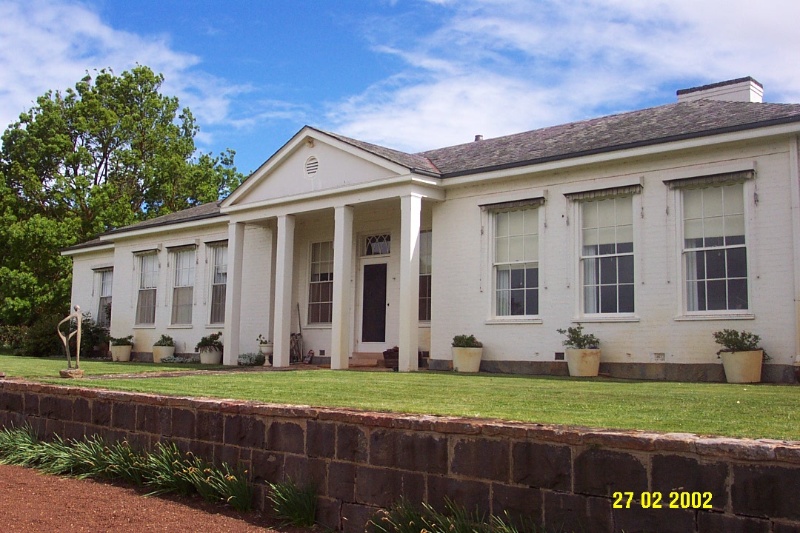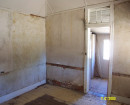Back to search results
NAREEB NAREEB HOMESTEAD COMPLEX
Chatsworth Road, GLENTHOMPSON VIC 3293 - Property No 0025
NAREEB NAREEB HOMESTEAD COMPLEX
Chatsworth Road, GLENTHOMPSON VIC 3293 - Property No 0025
All information on this page is maintained by Southern Grampians Shire.
Click below for their website and contact details.
Southern Grampians Shire
-
Add to tour
You must log in to do that.
-
Share
-
Shortlist place
You must log in to do that.
- Download report

23413 Nareeb Nareeb facade 1672

On this page:
Statement of Significance
What is significant?
The Nareeb Nareeb squatting run, located on the north-west corner of the intersection of the Hamilton-Chatsworth Road and the Glenthompson-Caramut Road on Gray Creek, was taken up in 1840 by Charles Gray. It was originally part of the as Green Hill Creek run at Lake Repose. Gray was the principal member of a partnership with William P. Scott and John Marr. Scott soon left the partnership. Green Hill was subdivided in 1846, Marr taking the northern half as Brie Brie and Gray the other as Nareeb Nareeb. Having obtained the pre-emptive right and purchased much of land under the Land Selection Acts in the 1860s, Gray stayed at Nareeb Nareeb until 1886. He built three dwellings in his time there, the first a rough hut in the early 1840s, the second a timber cottage in 1851 and finally, in 1884, a substantial stone house. The architect was a local, the English-born William Smith, who was also the town clerk of Hamilton. Sober and conservative, this and its predecessor were clearly informed by the Picturesque aesthetic with a deliberate modification of their spectacular landscape. He also made substantial improvements including a wool shed and sheep wash complex, which was advanced as a model for the district. He focused his efforts on breeding and could fairly claim that his sheep were probably the best in the district. Having suffered early losses to bush fire, he made special efforts to protect Nareeb Nareeb with firebreaks. When the Beggs family took over the property in 1886, the focus on breeding continued. Throughout the twentieth century, increasingly sophisticated systems were used with great success. Ironically, Nareeb Nareeb did suffer from disastrous bush fires, with almost everything being lost in fires after the Second World War. The present homestead complex is sited in the same position as the 1884 house and garden and enjoys the same dramatic panorama of the Grampians. The house is neo-Georgian in style, a relatively late example that continues the conservative tradition established by Charles Gray. The present house and garden are in excellent condition and retain a very high degree of integrity.
How is it significant?
Nareeb Nareeb homestead is of historic and architectural significance to the Shire of Southern Grampians.
Why is it significant?
Nareeb Nareeb homestead is of historic significance for its early beginnings and connection with Charles Gray, a very successful pastoralist who developed a model grazing property and was a highly respected leader of the community. The Beggs family, the second owners of the property, continue his role as sheep breeders and as promoters of the wool industry. Notwithstanding Gray's great concern about bushfire, the property was devastated by bushfires in the mid-twentieth century, only to survive and prosper. Nareeb Nareeb is of architectural significance for the continuity of its well informed but conservative approach to domestic architecture and the surrounding landscape.
The Nareeb Nareeb squatting run, located on the north-west corner of the intersection of the Hamilton-Chatsworth Road and the Glenthompson-Caramut Road on Gray Creek, was taken up in 1840 by Charles Gray. It was originally part of the as Green Hill Creek run at Lake Repose. Gray was the principal member of a partnership with William P. Scott and John Marr. Scott soon left the partnership. Green Hill was subdivided in 1846, Marr taking the northern half as Brie Brie and Gray the other as Nareeb Nareeb. Having obtained the pre-emptive right and purchased much of land under the Land Selection Acts in the 1860s, Gray stayed at Nareeb Nareeb until 1886. He built three dwellings in his time there, the first a rough hut in the early 1840s, the second a timber cottage in 1851 and finally, in 1884, a substantial stone house. The architect was a local, the English-born William Smith, who was also the town clerk of Hamilton. Sober and conservative, this and its predecessor were clearly informed by the Picturesque aesthetic with a deliberate modification of their spectacular landscape. He also made substantial improvements including a wool shed and sheep wash complex, which was advanced as a model for the district. He focused his efforts on breeding and could fairly claim that his sheep were probably the best in the district. Having suffered early losses to bush fire, he made special efforts to protect Nareeb Nareeb with firebreaks. When the Beggs family took over the property in 1886, the focus on breeding continued. Throughout the twentieth century, increasingly sophisticated systems were used with great success. Ironically, Nareeb Nareeb did suffer from disastrous bush fires, with almost everything being lost in fires after the Second World War. The present homestead complex is sited in the same position as the 1884 house and garden and enjoys the same dramatic panorama of the Grampians. The house is neo-Georgian in style, a relatively late example that continues the conservative tradition established by Charles Gray. The present house and garden are in excellent condition and retain a very high degree of integrity.
How is it significant?
Nareeb Nareeb homestead is of historic and architectural significance to the Shire of Southern Grampians.
Why is it significant?
Nareeb Nareeb homestead is of historic significance for its early beginnings and connection with Charles Gray, a very successful pastoralist who developed a model grazing property and was a highly respected leader of the community. The Beggs family, the second owners of the property, continue his role as sheep breeders and as promoters of the wool industry. Notwithstanding Gray's great concern about bushfire, the property was devastated by bushfires in the mid-twentieth century, only to survive and prosper. Nareeb Nareeb is of architectural significance for the continuity of its well informed but conservative approach to domestic architecture and the surrounding landscape.
Show more
Show less
-
-
NAREEB NAREEB HOMESTEAD COMPLEX - Historical Australian Themes
Theme 3: Developing local, regional and national economies
3.5 Developing primary production
3.5.1 Grazing stock
3.5.2 Breeding animals
3.5.3 Developing agricultural industries
Theme 5: Working
5.8 working on the landNAREEB NAREEB HOMESTEAD COMPLEX - Usage/Former Usage
Grazing
NAREEB NAREEB HOMESTEAD COMPLEX - Integrity
Very high degree of integrity.
NAREEB NAREEB HOMESTEAD COMPLEX - Physical Description 3
Nareeb-Nareeb Pre-emptive Right
Heritage Study and Grading
Southern Grampians - Southern Grampians Shire Heritage Study
Author: Timothy Hubbard P/L, Annabel Neylon
Year: 2002
Grading:
-
-
-
-
-
WOODHOUSE-NAREEB SOLDIERS MEMORIAL HALL
 Victorian Heritage Register H2275
Victorian Heritage Register H2275 -
Woodhouse-Nareeb Soldiers Memorial Hall Complex
 Vic. War Heritage Inventory
Vic. War Heritage Inventory -
Nareeb Nareeb Homestead
 National Trust
National Trust
-
1 Miller Street
 Yarra City
Yarra City -
1-3 Rowena Parade
 Yarra City
Yarra City
-
-












